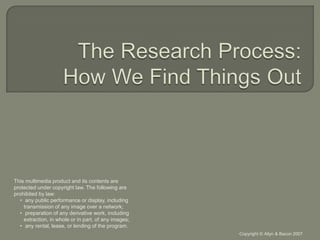
Chapter 1 (continued)
- 1. The Research Process:How We Find Things Out
- 2. The Scientific Method What are the components of the scientific method? Specify a problem Systematic observation Data Form a hypothesis Test the hypothesis Collect more data Formulate a theory Test the theory
- 3. The Scientific Method What is the relationship between theory, prediction (hypothesis), and data? Prediction Theory Data Theory development, validation, correction
- 4. Research Descriptive Naturalistic observation Allows one to see patterns in the real world Case studies Focus on a single interesting case in detail Surveys A set of questions put to a number of participants about their beliefs, attitudes, preferences, or activities Experimental Manipulate variables under controlled conditions
- 5. Designing Experiments: Independent Variable The aspect of a situation that is intentionally varied while another aspect is measured Examples Amount of practice allowed Participants randomly assigned so that they receive a drug or placebo Present visual or auditory stimuli Temperature of room
- 6. Designing Experiments: Dependent Variable The aspect of a situation that is measured while the independent variable is changed Examples Number of words recalled Speed of response Number of cigarettes smoked Electrical activity in the brain
- 7. Designing Experiments: Effects The difference in the dependent variable that is due to changes in the independent variable Examples Drug X impairs short-term memory Visualization improves athletic performance Practice improves reading speed
- 8. Experiments Experimental group Control group Random assignment Strengths and Weaknesses? Strengths Rigorous control, causal inferences Weaknesses Not all variables can be manipulated
- 9. Being a Critical Consumer Reliability Validity
- 10. Bias and Expectation Response bias Sampling bias Experimenter expectancy effects Double-blind design
- 12. A placebo (Latin for "I shall please") is a medication or treatment believed by the administrator of the treatment to be inert or innocuous.
- 13. Placebos may be sugar pills or starch pills.
- 15. Descriptive Statistics Used to describe the basic features of the data in a study Provides simple summaries about the sample and the measures Help us to simplify large amounts of data in a sensible way.
- 16. Descriptive Statistics Central Tendency Mean Median Normal distribution Variability Range Standard deviation Relative standing Percentile rank Percents
- 18. Expressed in terms of probability (p)Psychologists generally view a finding as “statistically significant” if it has no more than a 5% probability of occurring by chance p < .05 or smaller
- 19. Correlational Research Studies where the relationships between two or more variables are measured but not manipulated Examples Family income and IQ score Height and shoe size MAO levels and thrill seeking
- 20. Correlation Strength and direction
- 21. Correlation Research: Strengths and Weaknesses Strength Some study variables cannot be manipulated Weakness Correlation does not imply causation
- 22. Lying with Graphs Shortening the Y axis
- 23. Lying with Graphs Lengthening the Y axis
- 26. Informed consent
- 27. Avoid deception unless necessary
- 28. Debriefing
- 32. Tuskeegee Syphilis Trials Tuskegee Syphilis Experiment
